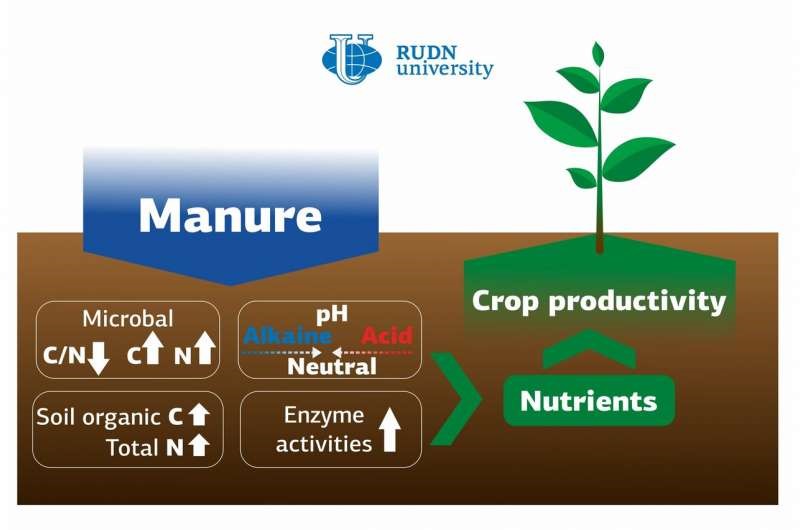Biologists summarize 520 studies and report the best way to fertilize soil

Manure has been used as a source of nutrients for plants since ancient times. However, until recently, no large-scale systematic analysis of this organic fertilizer has been conducted. A team of biologists (including several specialists from RUDN Unversity) reviewed over 500 prominent scientific works on the effect of manure on the quality of soils and have provided systematically and statistically generalized data about manure fertilization.
“Despite the abundance of individual works, no generalized analysis of the effect of manure on different soil properties has been carried out yet. We analyzed 521 works that covered both single-time and continuous use of manure in short- and long-term (up to 113 years) field experiments. Our team also developed a concept of changes in biological processes under the influence of manure depending on climate factors and soil properties,” said Evgeniya Blagodatskaya, a Ph.D. in biology and a senior researcher at the Center for Mathematical Modeling and Design of Sustainable Ecosystems at RUDN University.
When choosing the studies for their meta-analytical work, the team followed strict criteria. Each study had to contain accurate information about the source of the fertilizer and enzymes associated with carbon and nutrient cycles, have an unfertilized control lot, and provide different data and characteristics for statistical analysis. The meta-analysis covered different types of soils and climate zones with an average annual temperature from 10 to 20 degrees C and precipitation from 250 to 1,000 mm.
Having summarized the studies, the team suggested an optimal annual amount of manure for fertilization—25,000 kg per 1 ha. This ratio provides the best balance of yield and soil fertility and helps maintain soil acidity on the level that is the most beneficial for agriculture. However, this value cannot be considered a universal norm: Even though it has been calculated for different climate conditions and soil types, further studies will require a larger database. According to the team, manure is capable of accelerating the biochemical cycles of carbon and nitrogen by up to 30%. Notably, pig manure has a strong influence on the biochemical properties of the nitrogen cycle. After soil is fertilized with manure (especially if it is free from mineral additives), the enzymes that play a role in chemical transformations of carbon, nitrogen, sulfur, and phosphorus compounds become more active. Moreover, manure increases soil porosity and therefore increases its ability to retain water.
Besides the advantages of organic fertilizers, the team pointed out two risk factors that may occur if manure is not handled properly: pathogens and environmental pollution with greenhouse gases and nitrogen and phosphorus compounds. As a part of a well-designed strategy, manure fertilizers can solve many issues confronting the agricultural industry: reducing soil degradation and improving fertility, increasing carbon reserves, accelerating the cycles of key elements and making them available to plants.
The results of the study were published in Science of The Total Environment.
Matilda Pavlovna Mityaeva was born in 1925. In November 1942, she volunteered for frontline duty. She participated in the Great Patriotic War from November 1942 to June 1945 as part of the 53rd Infantry Division of the 475th Infantry Regiment. She was wounded twice.
The team led by Sergey Zyryanov, Head of the Department of General and Clinical Pharmacology, became the winner of the All-Russian competition of scientific projects "Technologies for Human Health".
RUDN University constantly adapts to the changes of the modern world and responds to challenges flexibly. This allows us to keep the standard of a world-class research university. The sphere of science is no exception. Peter Dokukin, Head of the Research Division, presented the updated R&D Programme at the meeting of the RUDN University Academic Council.
Matilda Pavlovna Mityaeva was born in 1925. In November 1942, she volunteered for frontline duty. She participated in the Great Patriotic War from November 1942 to June 1945 as part of the 53rd Infantry Division of the 475th Infantry Regiment. She was wounded twice.
The team led by Sergey Zyryanov, Head of the Department of General and Clinical Pharmacology, became the winner of the All-Russian competition of scientific projects "Technologies for Human Health".
RUDN University constantly adapts to the changes of the modern world and responds to challenges flexibly. This allows us to keep the standard of a world-class research university. The sphere of science is no exception. Peter Dokukin, Head of the Research Division, presented the updated R&D Programme at the meeting of the RUDN University Academic Council.